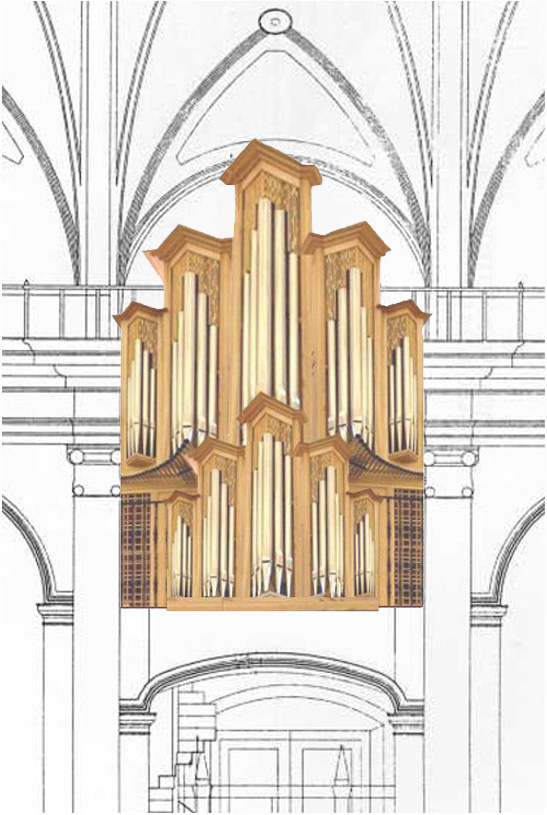BACKGROUND AND PROJECT OF
THE NEW ORGAN
Actually, the Basilica owns an organ
built by Organería Española, S.A. (OESA-Alberdi), with electrical transmission,
placed in one side of the building, over the “Porta de l’Aire”.
The organ has many electrical
problems due to the time pass and the flood of 1981, although it has been
repaired several times. These problems are, between others, the following ones:
pipes remain sounding when organist stop playing keys, stops or ranks which does
not act, …
It is necessary to substitute this
organ by other one in an eclectic manner, in order to be able to play any kind
of organ music, taking into special account the Iberic music in the XVII and
XVIII centuries. This is because in Algemesí was born Joan Bta. Cabanilles in
1644. He was a great organist and a genial composer in the Spanish Baroque
period.
Thus, it has been projected an organ
with mechanical transmission, with three keyboards and positive organ (“cadireta”)
at the back. The here-presented project is according with the specifications
that the technical commission proposed in its moment.
This instrument will be placed in
the actual location of the OESA organ, with 4’50 meters width and 3’20 meters
long. The tribune where it is placed the main façade will have as a projecting
element the positive organ (“cadireta”). This project will have a mechanical
transmission and windchest of sliders (52 sets in total). The registration could
be done by means of a computer to facilitate its memorization.
Basically, the organ will consist of
a console with three manual keyboards, with 56 keys each one, and a parallel
clavier pedal with 30 keys, in BDO norm. It will be located between the main
body of the organ and the positive organ (“cadireta”). This layout is common in
the organs with mechanic system.
- The first
keyboard plays the external and interior positive organ (“cadireta”). The
first one is a copy of the great organ at half size and it constitutes a
complete organ in itself. It is placed at the projecting part of the tribune,
at the back of the organist, and it has its own furniture. The interior one
has only sets of tiples and it goes in expression, in echos’
case shape.
- The second
keyboard plays the great organ, which is constituted of several sets of the
main one, as well as some flute pipe and inside trumpet pipes. This keyboard
is the one which gives the organ its most characteristic sound.
- The third
keyboard governs the expressive organ independently and the external battle
trumpet pipes in chamade, giving another soloist rank known as the corneta
magna. The expressive is appropriate for romantic music playing and it is
enclosed in a case with swells (in Venetian blinds shape).
- The clavier
pedal operates its own windchest and it can be connected to the other
keyboards.
- The sliding
mechanisms of the windchest registers, as well as the connections, are powered
by double action electrical motors, which at its turn are controlled by means
of retractable handles from the organ console (also called key stops). The
system allows the memorization of registers through a computer system.
- The organ case
is the building location where it is placed the main part of the organ. The
façade is constituted with five castles in miter shape, which are connected to
the 25 main flute pipes. Under this pipes are located the battle trumpet pipes
in chamade which are constituted by 3 sets, distributed in 3 groups of 3 rows.
- In the lower
level of the façade is located the console, with the three manual keyboards
and the clavier pedal. In each side the stops controls which activates
the different sets of pipes.
- The positive
organ at the back (“cadireta”) is placed at the tribune level and at the
projected part. It is complete case which reproduces the façade of the great
organ at half size.
- In case it was
a non-painted furniture, the case would be built in oak tree wood. But if it
would be a bleached furniture, it can be used another kind of wood.
- The system will
be blown by one fan Laukhuff of 14 m3 at 120 mm of water column.
The wind given by the fan will have several independent systems to regulate
the pressure.
The
following table presents the ranks which are settled for the organ of Algemesí,
with the number of pipes which each register is composed.

Font: Hermano D. Julio Longares
After the whole building and assembly process, here you
are a simulation of a possible configuration of the organ.

Berenguer & Díaz, S.L., Organers
(http://www.berendiaz.com)


